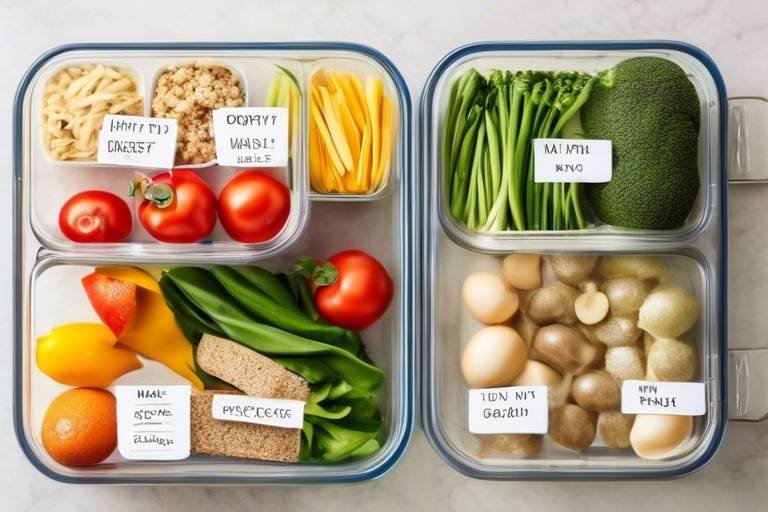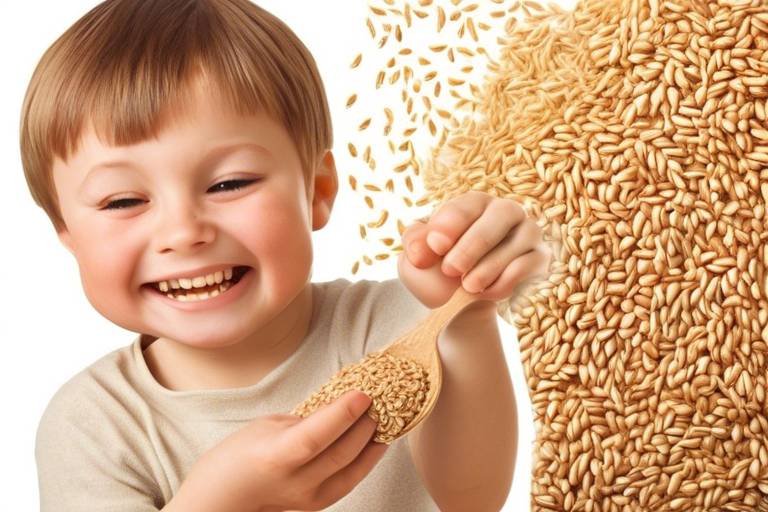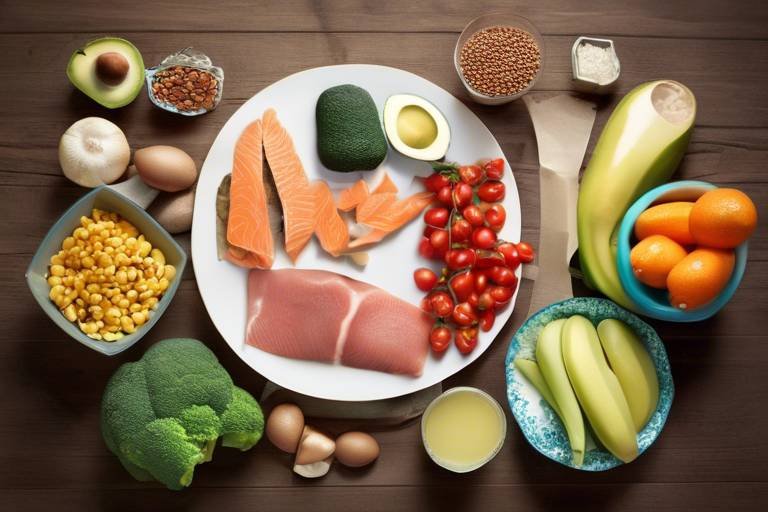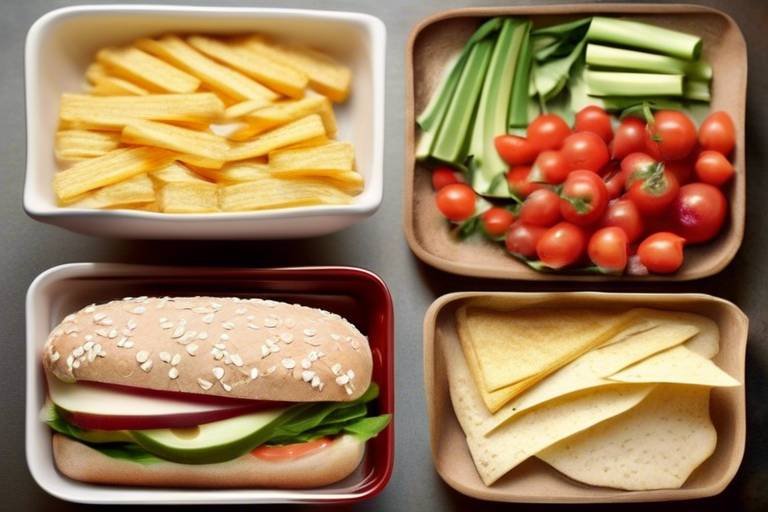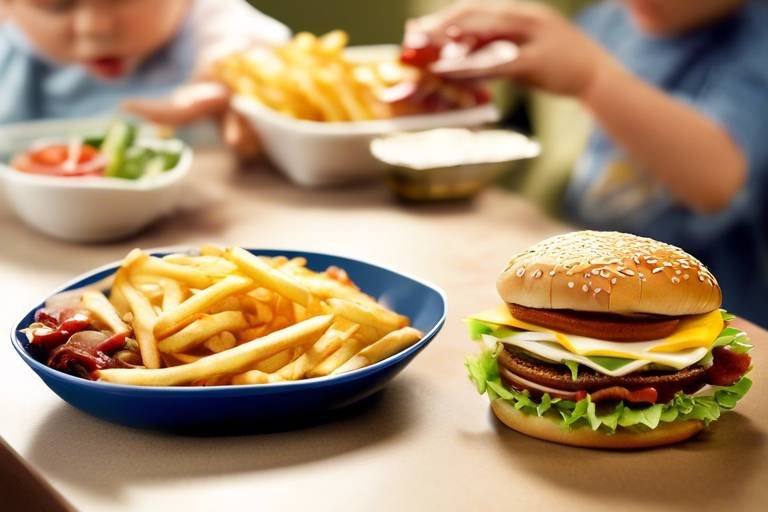Guide to Nutritional Requirements for Teenagers
This article explores the essential nutritional needs of teenagers, highlighting key dietary components, the importance of balanced meals, and tips for maintaining healthy eating habits during this critical growth phase.
The teenage years are a whirlwind of change, both physically and emotionally. During this time, adolescents experience rapid growth and development, making their nutritional needs unique compared to children and adults. It's not just about eating more; it's about eating right. Teenagers require a well-rounded diet that supports their energy levels, mental health, and overall well-being. Imagine your body as a high-performance vehicle—just like a car needs the right fuel to run smoothly, teenagers need the right nutrients to thrive. This includes a mix of carbohydrates, proteins, and fats, all of which play pivotal roles in their growth and daily activities.
Macronutrients are the cornerstone of a teenager's diet. These include carbohydrates, proteins, and fats, each serving a distinct purpose in the body. Understanding how these macronutrients work can help teenagers make informed food choices. For instance, carbohydrates are the body's primary energy source, while proteins are essential for growth and tissue repair. Fats, often misunderstood, are crucial for hormone production and brain health. So, how much of each macronutrient do teenagers actually need? The general recommendations are as follows:
| Macronutrient | Recommended Daily Intake |
|---|---|
| Carbohydrates | 45-65% of total daily calories |
| Proteins | 10-30% of total daily calories |
| Fats | 25-35% of total daily calories |
Carbohydrates are the primary energy source for active teenagers. Think of them as the fuel that keeps the engine running. When it comes to carbohydrates, not all options are created equal. There are two main types: simple and complex. Simple carbohydrates, found in sugary snacks and beverages, can give a quick energy boost but often lead to a crash later on. In contrast, complex carbohydrates, such as whole grains, fruits, and vegetables, provide sustained energy and are packed with essential nutrients.
Understanding the difference between simple and complex carbohydrates helps teens make better food choices. Simple carbs can be likened to a sprint—they provide quick energy but don't last long. On the other hand, complex carbs are more like a marathon—they provide a steady release of energy that keeps you going for longer. This is why incorporating complex carbohydrates into daily meals is vital for maintaining energy levels throughout the day.
So, what are some healthy carbohydrate sources? Here are a few that should definitely find a place in a teenager's diet:
- Whole grains: Brown rice, quinoa, whole wheat bread
- Fruits: Bananas, berries, apples
- Vegetables: Spinach, broccoli, carrots
These foods not only provide energy but also important vitamins and minerals that support overall health.
Proteins are crucial for growth and repair during the teenage years. They are the building blocks of muscles, skin, and hormones. Imagine proteins as the construction workers of your body—without them, growth stalls and recovery slows. Teenagers need about 46-52 grams of protein daily, depending on their age and activity level. Good sources of protein include:
- Lean meats: Chicken, turkey, and fish
- Dairy: Milk, yogurt, and cheese
- Plant-based options: Beans, lentils, tofu, and nuts
Fats are essential for hormone production and brain health, but distinguishing between healthy and unhealthy fats is crucial for teenagers. Healthy fats, found in foods like avocados, nuts, and olive oil, contribute to overall wellness, while unhealthy fats, often found in processed snacks and fast food, can lead to health problems.
Healthy fats are like the good guys in the superhero movie of nutrition. They support vital functions and help keep the body running smoothly. Unhealthy fats, however, are the villains that can wreak havoc on health. It's essential for teens to choose healthy fats over unhealthy ones. For example:
- Healthy Fats: Avocados, nuts, seeds, and fatty fish
- Unhealthy Fats: Fried foods, baked goods, and processed snacks
Incorporating healthy fats into meals doesn't have to be complicated. Here are a few practical tips:
- Add slices of avocado to sandwiches or salads.
- Snack on a handful of nuts instead of chips.
- Use olive oil for cooking or as a salad dressing.
By making these small changes, teenagers can enjoy delicious meals while ensuring they receive the necessary nutrients without excess unhealthy fats.
Q: How can I encourage my teenager to eat healthier?
A: Start by involving them in meal planning and preparation. Make healthy eating fun by trying new recipes together!
Q: What should I do if my teen is a picky eater?
A: Be patient and offer a variety of foods. Sometimes it takes several tries before they’ll accept a new food.
Q: Are supplements necessary for teenagers?
A: Ideally, teenagers should get their nutrients from food. However, if there are dietary restrictions, consult a healthcare professional about supplements.

Understanding Teenage Nutrition
The teenage years are a whirlwind of change, both physically and emotionally. During this critical phase, teenagers experience rapid growth and development, which makes nutrition more important than ever. But what exactly does that mean? Well, it’s not just about eating more food; it’s about eating the right food. Unlike children and adults, teenagers have unique nutritional needs that must be met to support their active lifestyles and ongoing development.
During adolescence, the body undergoes significant changes, including increased muscle mass, bone density, and hormonal shifts. These changes require an adequate intake of essential nutrients to fuel growth and maintain energy levels. For instance, teenagers need more calories than younger children due to their heightened activity levels and metabolic rates. But it’s not just about quantity; the quality of those calories is equally crucial. A balanced diet rich in vitamins, minerals, and macronutrients is essential for optimal health.
So, what should teenagers focus on? Here are some key components of a teen's diet that shouldn’t be overlooked:
- Fruits and Vegetables: Packed with vitamins and minerals, these should be a staple in every teenager's diet.
- Whole Grains: A great source of energy, whole grains provide necessary fiber and nutrients.
- Protein: Essential for muscle growth and repair, protein should come from a variety of sources.
- Dairy: Important for bone health, dairy products offer calcium and vitamin D.
- Healthy Fats: Necessary for brain health and hormone production, these should be included in moderation.
In addition to these components, it's also vital for teenagers to stay hydrated. Water is often overlooked but is essential for every bodily function, from digestion to temperature regulation. Encouraging teens to drink plenty of water throughout the day can significantly impact their overall health and energy levels.
Let's not forget about the social aspect of eating. Teenagers often find themselves in situations where peer pressure can influence their dietary choices. Whether it’s hanging out with friends at a fast-food joint or attending parties with tempting snacks, it’s important for teens to develop a healthy relationship with food. Understanding the nutritional value of what they’re consuming can empower them to make better choices, even in less-than-ideal situations.
In summary, teenage nutrition is about more than just filling up on calories; it’s about ensuring that those calories come from a variety of nutritious sources to support growth, energy, and overall well-being. By focusing on a balanced diet that includes all the essential nutrients, teenagers can set themselves up for a lifetime of healthy eating habits.

Macronutrients: The Building Blocks
When it comes to fueling the bodies of teenagers, macronutrients are the unsung heroes. These essential nutrients—carbohydrates, proteins, and fats—are the building blocks of a healthy diet and play a crucial role in the growth and development of adolescents. During these transformative years, teenagers experience rapid physical changes, which means their nutritional needs are unique compared to both children and adults.
Understanding the importance of each macronutrient is vital for teenagers aiming to maintain energy levels, build muscle, and support overall health. So, let's break it down:
| Macronutrient | Role in the Body | Recommended Daily Intake |
|---|---|---|
| Carbohydrates | Primary energy source | 45-65% of total daily calories |
| Proteins | Growth and repair of tissues | 10-30% of total daily calories |
| Fats | Hormone production and brain health | 20-35% of total daily calories |
Carbohydrates are particularly important for teenagers, especially those who are active in sports or other physical activities. They provide the necessary energy to keep up with demanding schedules. Think of carbohydrates as the fuel for a car; without it, the engine simply won't run. But not all carbohydrates are created equal. It's essential for teens to choose nutritious sources that will keep their energy levels stable throughout the day.
Next up is protein, which is essential for building muscles and repairing tissues. During the teenage years, the body is growing rapidly, and protein is needed to support that growth. It’s like the bricks in a house; without them, the structure would collapse. Good sources of protein include lean meats, dairy products, beans, and nuts. It's important for teens to ensure they get enough protein to support their active lifestyles.
Finally, we have fats. While many people think of fats as something to avoid, they are actually crucial for hormone production and brain health. However, not all fats are beneficial. Teenagers should focus on consuming healthy fats, such as those found in avocados, nuts, and olive oil, while limiting unhealthy fats from processed foods. This is akin to choosing the right kind of oil for a machine; the right oil keeps everything running smoothly.
In summary, a balanced intake of macronutrients is essential for teenagers to thrive during these critical developmental years. By understanding the roles of carbohydrates, proteins, and fats, teens can make informed choices that will support their growth, energy levels, and overall health. Remember, nutrition is not just about filling your stomach; it’s about fueling your body for success!
- What are macronutrients? Macronutrients are nutrients that provide energy and are essential for growth and development. They include carbohydrates, proteins, and fats.
- How much protein do teenagers need? Teenagers should aim for 10-30% of their total daily calories to come from protein sources.
- Are all fats bad for you? No, not all fats are bad. Healthy fats are essential for hormone production and brain health, while unhealthy fats should be limited.

Carbohydrates: Energy Source
When it comes to fueling the bodies of teenagers, carbohydrates are like the high-octane fuel for a sports car. They are the primary source of energy, especially for those who are constantly on the move—whether it's sprinting down the basketball court, cycling with friends, or simply keeping up with a busy school schedule. But not all carbs are created equal! Understanding the difference between various types of carbohydrates can empower teens to make better food choices that support their active lifestyles.
Carbohydrates can be broadly categorized into two types: simple carbohydrates and complex carbohydrates. Simple carbohydrates, found in sugary snacks and drinks, provide a quick burst of energy but can lead to a crash shortly after. On the other hand, complex carbohydrates, which are found in whole grains, legumes, and vegetables, break down more slowly, providing sustained energy that helps keep teens alert and focused throughout the day. It's like the difference between a quick sugar rush from candy and the steady, reliable energy from a bowl of oatmeal!
Here’s a quick breakdown of the two types:
| Type of Carbohydrate | Examples | Benefits |
|---|---|---|
| Simple Carbohydrates | Sugary snacks, soda, white bread | Quick energy boost |
| Complex Carbohydrates | Whole grains, fruits, vegetables | Sustained energy, fiber-rich |
So, what are some healthy carbohydrate sources that teenagers should include in their diets? Here are a few suggestions:
- Whole Grains: Foods like brown rice, quinoa, and whole wheat bread are packed with nutrients and fiber.
- Fruits: Fresh fruits like bananas, apples, and berries not only satisfy sweet cravings but also provide vitamins and minerals.
- Vegetables: Leafy greens and root vegetables are excellent sources of complex carbohydrates and essential nutrients.
Incorporating a variety of these carbohydrate sources into meals and snacks can help ensure that teenagers get the energy they need to thrive. For instance, starting the day with a bowl of oatmeal topped with fruits can provide lasting energy for morning classes, while a whole grain wrap filled with veggies and lean protein makes for a great lunch option. Remember, the key is balance—pairing carbohydrates with proteins and healthy fats can create a well-rounded meal that supports overall health and well-being.
As we dive deeper into the world of nutrition, it's essential for teens to recognize how vital carbohydrates are for their growth and energy levels. Making informed choices about the types of carbs they consume can set the stage for a healthier future, ensuring they not only feel good but also perform at their best, both physically and mentally.
- How many carbohydrates should teenagers consume daily? The recommended daily intake can vary, but generally, carbohydrates should make up about 45-65% of total daily calories.
- Are all carbohydrates bad? No! It's important to focus on complex carbohydrates and whole foods rather than refined sugars and processed snacks.
- Can I get enough energy from just carbohydrates? While carbohydrates are a key energy source, a balanced diet including proteins and healthy fats is essential for overall health.

Simple vs. Complex Carbohydrates
When it comes to carbohydrates, understanding the difference between simple and complex carbohydrates is essential for teenagers aiming for a healthy diet. Think of carbohydrates as fuel for your body, much like how gasoline powers a car. However, not all fuel is created equal, and the type of carbohydrate you consume can significantly impact your energy levels and overall health.
Simple carbohydrates are the quick-fix energy sources. They are found in foods that are sweet and processed, such as candies, sodas, and baked goods. These carbs are made up of one or two sugar molecules, which means they are rapidly digested and absorbed by the body. The downside? They can lead to a quick spike in blood sugar followed by a crash, leaving you feeling tired and irritable. Imagine riding a rollercoaster—it's thrilling at first, but the sudden drop can leave you feeling a bit queasy!
On the other hand, we have complex carbohydrates. These are your body's best friends, especially during the teenage years when growth and energy demands are high. Complex carbs consist of longer chains of sugar molecules, meaning they take longer to break down and provide a more sustained release of energy. Foods like whole grains, legumes, and vegetables fall into this category. They are packed with essential nutrients and fiber, which not only helps keep you full but also supports digestive health. Think of complex carbs as a steady stream of energy, keeping you powered up throughout the day without the rollercoaster effect.
Here’s a quick comparison to help you visualize the differences:
| Type of Carbohydrate | Examples | Benefits |
|---|---|---|
| Simple Carbohydrates | Sugary snacks, sodas, white bread | Quick energy boost, but can cause energy crashes |
| Complex Carbohydrates | Whole grains, legumes, fruits, vegetables | Sustained energy, rich in nutrients, supports digestion |
To sum it up, while simple carbohydrates might offer a quick burst of energy, they can leave you feeling drained shortly after. Complex carbohydrates, however, are like a reliable friend, providing lasting energy and essential nutrients. For teenagers, who are often busy with school, sports, and social activities, incorporating more complex carbs into their meals can help maintain energy levels and support overall health.
So, the next time you're reaching for a snack, think about whether you're fueling your body with a quick sugar rush or giving it the long-lasting energy it needs to thrive. Choosing wisely can make all the difference!

Healthy Carbohydrate Sources
When it comes to fueling the bodies of teenagers, are like the premium gasoline for a high-performance car. Just as a car needs the right fuel to run smoothly, teenagers require quality carbohydrates to support their growth, energy levels, and overall health. So, what exactly qualifies as a healthy carbohydrate? Let’s break it down!
First off, whole grains are a fantastic starting point. Unlike their refined counterparts, whole grains retain all parts of the grain kernel, meaning they are packed with fiber, vitamins, and minerals. Think of foods like brown rice, quinoa, and whole wheat bread. These foods not only provide sustained energy but also help keep the digestive system running smoothly. It's like having a well-oiled machine!
Next up, we have fruits. They are nature's candy, bursting with natural sugars, fiber, and essential nutrients. Fruits like bananas, apples, and berries are not just delicious but also provide a quick energy boost before or after a workout. Plus, they are easy to grab on the go, making them perfect for busy teens. Imagine biting into a juicy apple or a sweet strawberry—it’s like a mini celebration for your taste buds!
Let’s not forget about vegetables. While they might not be the first thing that comes to mind when you think of carbohydrates, many vegetables contain healthy carbs that are essential for a balanced diet. Sweet potatoes, carrots, and peas are excellent examples. They provide energy and are loaded with vitamins and minerals that support overall health. Think of them as the unsung heroes of the carbohydrate world!
To make it even clearer, here’s a quick comparison table of healthy carbohydrate sources:
| Food Group | Examples | Benefits |
|---|---|---|
| Whole Grains | Brown rice, Quinoa, Oats | High in fiber, sustained energy |
| Fruits | Apples, Bananas, Berries | Natural sugars, vitamins, easy snacks |
| Vegetables | Sweet potatoes, Carrots, Peas | Rich in nutrients, fiber, low calorie |
Incorporating these healthy carbohydrate sources into daily meals can be as simple as adding a side of quinoa to dinner, snacking on fruits during the day, or enjoying a colorful vegetable stir-fry. The key is variety! By mixing and matching these foods, teenagers can ensure they are getting the energy they need without sacrificing taste or nutrition. Remember, a well-balanced plate is not only appealing to the eyes but also to the body!
So, the next time you’re planning meals or snacks, think about how you can include these healthy carbohydrate sources. They are not just food; they are the building blocks of a healthy lifestyle that supports growth, energy, and vitality during these formative years.
- What are the best sources of carbohydrates for teenagers?
Whole grains, fruits, and vegetables are excellent sources of healthy carbohydrates. - How many carbohydrates should teenagers consume daily?
Teenagers should aim for about 45-65% of their total daily calories to come from carbohydrates, focusing on healthy sources. - Can teenagers eat sugary snacks?
While sugary snacks can be enjoyed in moderation, it's important to prioritize healthier carbohydrate sources for sustained energy.

Proteins: Essential for Growth
When it comes to the teenage years, protein is often hailed as the superhero of nutrients. Why, you ask? Well, these are the years when your body is growing and changing at a rapid pace, and protein plays a crucial role in this transformation. Think of protein as the building blocks of your body, helping to create everything from muscle to hormones. Without sufficient protein, your growth might be stunted, and your body won't have the necessary resources to repair itself after injuries or intense physical activity.
So, how much protein do teenagers actually need? The general recommendation is about 46 grams per day for girls and 52 grams per day for boys, but this can vary depending on activity levels and individual health needs. If you're a budding athlete or just someone who loves to stay active, you might need even more! It’s important to incorporate a variety of protein sources into your diet to ensure you're getting all the essential amino acids your body requires.
Here’s a quick look at some fantastic protein sources you can include in your meals:
- Lean Meats: Chicken, turkey, and lean cuts of beef are excellent options.
- Fish: Salmon and tuna not only provide protein but also healthy fats!
- Dairy: Milk, yogurt, and cheese are packed with protein and calcium.
- Plant-Based Options: Beans, lentils, tofu, and quinoa are great for vegetarians and vegans.
Incorporating these protein sources into your meals can be as simple as adding grilled chicken to a salad, mixing beans into a stir-fry, or enjoying a smoothie with protein powder. Remember, variety is key! Eating a wide range of protein-rich foods ensures that you’re not only fueling your body but also keeping your meals exciting and tasty.
Now, let’s talk about the timing of protein consumption. Many experts suggest that spreading your protein intake throughout the day can be beneficial. Instead of loading up on protein at dinner, try to include a source of protein in every meal and snack. This could mean having a hard-boiled egg for breakfast, a yogurt parfait for a snack, and some grilled fish for dinner. This way, your body has a steady supply of amino acids to support growth and repair.
Lastly, don’t forget that while protein is essential, balance is crucial. Pairing protein with carbohydrates and healthy fats in your meals can help optimize your energy levels and overall health. So, the next time you're planning your meals, think about how you can make protein a star player on your plate!
1. How can I tell if I'm getting enough protein?
If you're feeling fatigued, experiencing muscle weakness, or not recovering well from workouts, you might not be getting enough protein. Keeping a food diary can help you track your intake.
2. Can I get enough protein from a vegetarian diet?
Absolutely! Plant-based sources like beans, lentils, tofu, and quinoa can provide all the protein you need. Just make sure to mix different sources to get a complete amino acid profile.
3. Is too much protein harmful?
While protein is essential, excessive amounts can strain your kidneys and lead to dehydration. It’s best to stick to recommended daily allowances unless advised otherwise by a healthcare professional.
4. What are some easy ways to add protein to my diet?
You can add protein by including nuts in your snacks, having eggs for breakfast, or using Greek yogurt in smoothies and desserts. It's all about being creative!

Fats: Not All Are Created Equal
When it comes to nutrition, fats often get a bad rap. But here’s the truth: fats are essential for our bodies, especially during the teenage years when growth and development are at their peak. Think of fats as the unsung heroes in the world of nutrition. They play a critical role in hormone production, brain health, and even the absorption of certain vitamins. However, not all fats are created equal, and understanding the differences can empower teenagers to make better dietary choices.
So, what exactly are these different types of fats? Generally, fats can be categorized into three main groups: saturated fats, unsaturated fats, and trans fats. Each type has its own effects on health, and knowing how to distinguish between them is key to maintaining a balanced diet.
Saturated fats, often found in animal products like butter, cheese, and fatty meats, can raise cholesterol levels and increase the risk of heart disease when consumed in excess. On the other hand, unsaturated fats, which are found in sources like olive oil, avocados, and nuts, are beneficial for heart health and should be included in a teenager's diet. Finally, trans fats, commonly found in processed foods and some margarines, are the real villains. They not only raise bad cholesterol levels but also lower good cholesterol, making them a type of fat to avoid at all costs.
To help illustrate the differences, here’s a quick comparison:
| Type of Fat | Sources | Health Effects |
|---|---|---|
| Saturated Fats | Butter, cheese, red meat | Can raise cholesterol; increase heart disease risk |
| Unsaturated Fats | Olive oil, avocados, nuts | Heart-healthy; can lower bad cholesterol |
| Trans Fats | Processed foods, fried foods | Increase bad cholesterol; lower good cholesterol |
Incorporating healthy fats into meals doesn’t have to be complicated. For instance, adding a handful of nuts to a salad or drizzling olive oil over vegetables can enhance flavor while providing essential nutrients. It's all about making smart choices. Remember: fats are not the enemy; it's the type of fat that matters. By focusing on unsaturated fats and minimizing saturated and trans fats, teenagers can enjoy delicious meals while supporting their health.
So, next time you’re planning a meal or snack, think about the fats you’re including. Are they nourishing your body or dragging you down? Making informed choices can set the foundation for a lifetime of healthy eating habits. And don’t forget, balance is key! A little bit of healthy fat can go a long way in fueling those busy teenage days.
- What are the best sources of healthy fats? Healthy fats can be found in foods like avocados, nuts, seeds, and olive oil.
- How much fat should teenagers consume daily? Generally, about 25-35% of total daily calories should come from fats, focusing on unsaturated sources.
- Are all saturated fats bad? Not all saturated fats are created equal, but it's best to limit their intake and choose healthier options when possible.
- How can I reduce trans fat intake? Avoid processed foods, read labels carefully, and opt for whole, unprocessed foods whenever you can.

Healthy Fats vs. Unhealthy Fats
The conversation around fats can often feel like navigating a minefield, especially for teenagers who are bombarded with mixed messages about what to eat. The truth is, not all fats are created equal, and understanding the difference between healthy fats and unhealthy fats is crucial for maintaining optimal health during these formative years. Healthy fats, such as those found in avocados, nuts, seeds, and fish, play a vital role in supporting brain function, hormone production, and overall well-being. They are essential for absorbing nutrients and can even help manage weight when consumed in moderation.
On the flip side, unhealthy fats, particularly trans fats and excessive saturated fats, can lead to a host of health issues, including heart disease and obesity. These unhealthy fats are commonly found in processed foods, fast foods, and baked goods. It's important for teenagers to be aware of these sources and make informed choices about what they consume. For instance, a quick glance at the nutrition label can reveal whether a snack contains trans fats, which should be avoided as much as possible.
To make things clearer, let’s break down the types of fats:
| Type of Fat | Sources | Health Impact |
|---|---|---|
| Healthy Fats | Avocados, olive oil, nuts, seeds, fatty fish | Supports heart health, brain function, and hormone production |
| Unhealthy Fats | Processed foods, fried foods, baked goods, margarine | Increases risk of heart disease, obesity, and diabetes |
Incorporating healthy fats into meals can be as simple as drizzling olive oil over a salad, snacking on a handful of almonds, or adding slices of avocado to a sandwich. These small changes can make a big difference in a teenager's overall diet. However, it’s also essential to be mindful of portion sizes. While healthy fats are beneficial, they are still calorie-dense, so moderation is key.
In summary, educating teens about the differences between healthy and unhealthy fats empowers them to make better dietary choices. By focusing on incorporating healthy fats into their daily meals while avoiding unhealthy options, teenagers can support their growth, energy levels, and long-term health. So, the next time you reach for a snack, think about what kind of fat is in it—your body will thank you!
- What are some examples of healthy fats? Healthy fats include avocados, olive oil, nuts, seeds, and fatty fish.
- Why are unhealthy fats bad for me? Unhealthy fats can lead to heart disease, obesity, and other health problems.
- How can I include healthy fats in my diet? You can add healthy fats by using olive oil in cooking, snacking on nuts, or adding avocado to meals.
- Is it okay to eat fat every day? Yes, but focus on healthy fats and consume them in moderation.

Incorporating Fats into Meals
This article explores the essential nutritional needs of teenagers, highlighting key dietary components, the importance of balanced meals, and tips for maintaining healthy eating habits during this critical growth phase.
Teenage years are crucial for growth and development. This section discusses the unique nutritional needs of adolescents and how these requirements differ from those of children and adults.
Macronutrients—carbohydrates, proteins, and fats—play a vital role in a teenager's diet. This section breaks down the importance of each macronutrient and recommended daily intake levels for optimal health.
Carbohydrates are the primary energy source for active teenagers. This subheading delves into the types of carbohydrates, their benefits, and the best sources to include in a teen's diet.
Understanding the difference between simple and complex carbohydrates helps teens make better food choices. This section explains how each type affects energy levels and overall health.
This section highlights nutritious carbohydrate sources such as whole grains, fruits, and vegetables, emphasizing their role in a balanced diet for teenagers.
Proteins are crucial for growth and repair during teenage years. This section discusses the importance of protein, its sources, and how much teenagers need for their active lifestyles.
Fats are essential for hormone production and brain health. This section outlines the different types of fats and their roles in a teenager's diet, emphasizing the importance of healthy fats.
Distinguishing between healthy and unhealthy fats is important for teenagers. This section explains the impact of each type on health and suggests healthier alternatives.
Incorporating healthy fats into meals is not just about adding flavor; it's about enhancing overall nutrition. Teenagers can benefit from including healthy fats in their diet in a variety of delicious and creative ways. For instance, consider using avocado as a spread on toast instead of butter. This not only adds a creamy texture but also provides essential fatty acids and nutrients.
Another fantastic way to include healthy fats is by using olive oil in salad dressings or for cooking. It’s rich in monounsaturated fats, which are good for heart health. When preparing meals, try drizzling olive oil over roasted vegetables or mixing it with vinegar for a tasty dressing. You can also incorporate nuts and seeds into snacks or meals; for example, adding a handful of almonds to yogurt or sprinkling chia seeds on a smoothie can boost both flavor and nutrition.
Moreover, incorporating fatty fish like salmon into the weekly menu can provide omega-3 fatty acids that are crucial for brain development. Aim for at least two servings of fish per week. For those who may not enjoy fish, consider plant-based sources of omega-3s such as flaxseeds and walnuts. These can easily be added to cereals or baked goods, making it simple to enhance the diet without a lot of fuss.
To make meal planning easier, here’s a simple table to illustrate some easy ways to incorporate healthy fats:
| Food Item | Healthy Fat Source | Meal Ideas |
|---|---|---|
| Avocado | Monounsaturated fats | Spread on toast, in salads |
| Olive Oil | Monounsaturated fats | Salad dressings, cooking |
| Salmon | Omega-3 fatty acids | Grilled, in salads, or as sushi |
| Nuts and Seeds | Healthy fats, fiber | Snacks, in yogurt, or smoothies |
Encouraging teenagers to experiment with different healthy fats can not only improve their diet but also make mealtime more enjoyable. It's all about balance and variety. By making small adjustments and being open to trying new foods, teens can easily incorporate healthy fats into their meals, supporting their growth and overall health.
Q: Why are fats important for teenagers?
A: Fats are essential for hormone production, brain health, and overall energy. They provide a concentrated source of energy and help absorb fat-soluble vitamins.
Q: How can I tell if I'm eating enough healthy fats?
A: Look for a balance in your diet. Including sources like avocados, nuts, seeds, and fatty fish can help ensure you're getting the right amount of healthy fats.
Q: Are all fats bad for me?
A: Not at all! While some fats, like trans fats, can be harmful, healthy fats from sources like olive oil, avocados, and fish are beneficial and necessary for your health.
Frequently Asked Questions
- What are the key nutritional needs for teenagers?
Teenagers require a balanced diet rich in macronutrients like carbohydrates, proteins, and healthy fats. They also need essential vitamins and minerals to support their rapid growth and development. It's crucial to focus on whole foods such as fruits, vegetables, whole grains, lean proteins, and healthy fats to meet these needs.
- How many calories do teenagers need daily?
The daily caloric needs for teenagers can vary based on age, sex, and activity level. On average, teenage girls need about 1,800 to 2,400 calories per day, while teenage boys require approximately 2,200 to 3,200 calories. Active teens may need more to fuel their growth and energy levels.
- What is the difference between simple and complex carbohydrates?
Simple carbohydrates are quick sources of energy, found in foods like candy and soda, while complex carbohydrates, found in whole grains and legumes, provide sustained energy. Choosing complex carbs over simple ones is beneficial for maintaining stable energy levels throughout the day.
- How much protein do teenagers need?
Teenagers should aim for about 46 grams of protein per day for girls and 52 grams for boys. Protein is vital for growth, muscle repair, and overall health, so incorporating sources like chicken, fish, beans, and dairy is essential.
- Are all fats bad for teenagers?
No, not all fats are bad! Healthy fats, such as those found in avocados, nuts, and olive oil, are essential for hormone production and brain health. It's important to limit unhealthy fats found in processed foods to maintain overall health.
- What are some healthy snack options for teenagers?
Healthy snacks can include options like Greek yogurt with fruit, hummus with veggies, or whole grain crackers with cheese. These snacks provide essential nutrients and energy without excessive sugars or unhealthy fats.
- How can teenagers maintain a balanced diet?
To maintain a balanced diet, teenagers should aim to fill half their plate with fruits and vegetables, include whole grains, choose lean proteins, and incorporate healthy fats. Planning meals ahead and being mindful of portion sizes can also help.
- What role do vitamins and minerals play in a teenager's diet?
Vitamins and minerals are crucial for various bodily functions, including bone health, immune function, and energy production. Teenagers should focus on getting a variety of nutrients from foods like fruits, vegetables, dairy, and whole grains to meet their growing needs.





